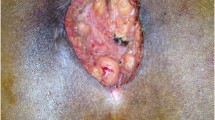Abstract
Background
Pilonidal disease is an inflammatory disease seen in the intergluteal region. In this study, our aim was to compare the efficacy of the Limberg flap versus a tension-free primary closure.
Methods
A total of 93 patients were included in this study. The patients were assigned consecutively by the closed-envelope technique to one of two groups: 49 patients in group 1 (excision and Limberg flap) and 44 patients in group 2 (tension-free primary closure). Excision and reconstruction with the Limberg flap was performed in its classic form. For tension-free primary closure after excision of the sinus tract with an elliptical incision, the skin and subcutaneous tissue were released 2–3 cm away from the incision line. The subcutaneous tissue was closed twofold with 2/0 polyglactin sutures. The skin underwent 3/0 polypropylene mattress suturing.
Results
The median age was 25 years (17–43 years). The median follow-up period was 29.5 months (8–43 months). There was no significant difference between the groups in terms of age, sex, follow-up time, or anesthesia method. One patient in each group experienced wound infection. During the first 6 months of follow-up there was no recurrence. However, at later visits recurrences were seen in two patients in each group (4.1% in group 1, 4.5% in group 2).
Conclusions
The lower rates of wound infection and recurrence associated with the Limberg flap reported elsewhere may be associated with healing of the tension-free procedure. In this study, tension-free primary closure was found to be as effective as the Limberg flap reconstruction.




Similar content being viewed by others
References
McCallum I, King PM, Bruce J (2007) Healing by primary versus secondary intention after surgical treatment for pilonidal sinus. Cochrane Database Syst Rev 17:CD006213
Akinci OF, Bozer M, Uzunköy A et al (1999) Incidence and aetiological factors in pilonidal sinus among Turkish soldiers. Eur J Surg 165:339–342
Alemderoğlu K, Akçal T, Buğra D (2003) Pilonidal Hastalık. Kolon Rektum ve Anal Bölge Hastalıkları, vol 1. Baskı, İstanbul, pp 185–196
Karydakis GE (1992) Easy and successful treatment of pilonidal sinus after explanation its causative process. Aust N Z J Surg 62:385–389
Harlak A, Menteş Ö, Kilic S et al (2010) Sacrococcygeal pilonidal disease: analysis of previously proposed risk factors. Clinics (Sao Paulo) 65:125–131
Conroy FJ, Kandamany N, Mahaffey PJ (2008) Laser depilation and hygiene: preventing recurrent pilonidal sinus disease. J Plast Reconstr Aesthet Surg 61:1069–1072
Odili J, Gault D (2002) Laser depilation of the natal cleft: an aid to healing the pilonidal sinus. Ann R Coll Surg Engl 84:29–32
Ağca B, Altınlı E, Duran Y et al (2002) Comparison of Limberg and primary reconstruction in treatment of pilonidal sinus. Çağdaş Cerrahi Dergisi 16:152–154
Mahdy T (2008) Surgical treatment of the pilonidal disease: primary closure or flap reconstruction after excision. Dis Colon Rectum 51:1816–1822
Al Hassan HK, Francis IM, Heglen P (1990) Primary closure or secondary granulation after excision of pilonidal sinus. Acta Chir Scand 156:144–146
Çubukçu A, Gönüllü NN, Paksoy M et al (2000) The role of the obesity on the recurrence of pilonidal sinus disease in patients, who were treated by excision and Limberg flap transposition. Int J Colorectal Dis 15:173–175
Akça T, Çolak T, Ustunsoy B et al (2005) Randomized clinical trial comparing primary closure with the Limberg flap in the treatment of the primary sacrococcygeal pilonidal disease. Br J Surg 92:1081–1084
Muzi MG, Milito G, Cadeddu F et al (2010) Randomized comparison of Limberg flap versus modified primary closure for the treatment of pilonidal disease. Am J Surg 200:9–14
Topgül K, Özdemir E, Kılıç K et al (2003) Long-term result of Limberg flap procedure for treatment of pilonidal sinus: a report of 200 cases. Dis Colon Rectum 46:1545–1548
Cihan A, Menteş BB, Tatlıcıoğlu E et al (2004) Modified Limberg flap reconstruction compares favourably with primary repair for pilonidal sinus surgery. ANZ J Surg 74:238–242
Tavassoli A, Noorshafiee S, Nazarzadeh R (2011) Comparison of excision with primary repair versus Limberg flap. Int J Surg 9:343–346. doi:10.1016/j.ijsu.2011.02.009
Author information
Authors and Affiliations
Corresponding author
Rights and permissions
About this article
Cite this article
Okuş, A., Sevinç, B., Karahan, Ö. et al. Comparison of Limberg Flap and Tension-Free Primary Closure During Pilonidal Sinus Surgery. World J Surg 36, 431–435 (2012). https://doi.org/10.1007/s00268-011-1333-y
Published:
Issue Date:
DOI: https://doi.org/10.1007/s00268-011-1333-y




